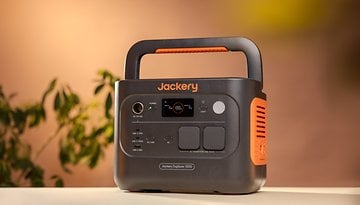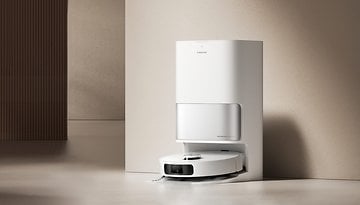Ecoflow Delta 2 Review: Smart and Efficient Power Station
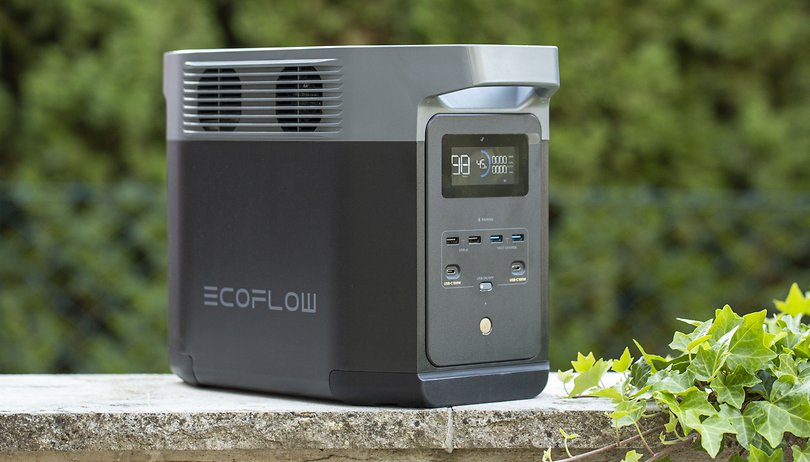

The Ecoflow Delta 2 is not only smart with Bluetooth, Wi-Fi, and its own app but also promises a lot of capacity and powerful output in a compact format. Read how the Ecoflow Delta 2 performs in practice in the NextPit review.
Good
- Power supply integrated into the case
- Many power connections
- App is more practical than expected
- Handles stick out sideways and protect the display and ports
- Inverter works very efficiently
- Expandable with additional battery
Bad
- Handles stick out sideways and get in the way
- More expensive than competitors with the same capacity
- Relatively loud at maximum load

EcoFlow Delta 2 release date and price
If you are looking for a smart and powerful power station, then the Ecoflow Delta 2 is the right choice. The relatively compact power station offers a strong output power and a decent capacity of 901 Wh. We also liked the app in the test, which allows you to control and monitor the power station from everywhere thanks to Bluetooth and Wi-Fi.
The only negative points in the test were the comparatively high price and the somewhat high volume under full load. The Ecoflow Delta 2 costs 999 dollars and is available in the manufacturer's online store or via Amazon.
EcoFlow Delta 2 design and build quality
The Ecoflow Delta 2 takes after its predecessors in terms of its design. The plastic housing is dark gray at the bottom, while the upper segment is made of silver plastic with the ends sporting two solid carrying handles —one on the right and the other on the left. The fact that the handles protrude sideways and remain fixed has its fair share of advantages and disadvantages.
Pros
- Sleek and sturdy design with solid build quality.
- Carrying handles protect the inputs and outputs.
- Chic and easy-to-read display.
- Practical app with WLAN and Bluetooth.
Cons
- Carrying handles make the power station unnecessarily wide.
The fact that the Ecoflow Delta 2's two handles protrude from the side and are fixed has advantages and disadvantages: On the one hand, they make the case wider and less practical to pack. On the other hand, they also protect the plugged-in cables from damage, since you can't accidentally push them completely against the wall. You have to decide for yourself whether this is an advantage or a disadvantage for you. The bottom of the power station is made of extremely non-slip rubber.
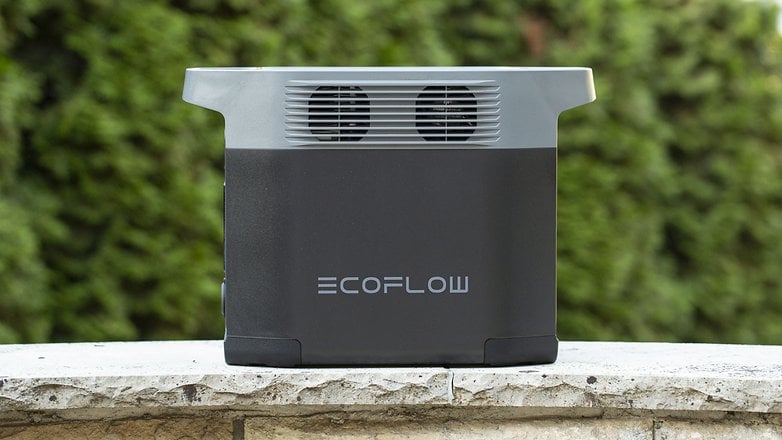
On the side of the Ecoflow Delta 2, there is a fancy display at the top that informs you about the charging status, input and output power, as well as possible problems or errors. Below that are four USB-A ports and two USB-C ports. There is a separate button to turn the USB unit on and off. Finally, you will find a general on/off button for the power station underneath.
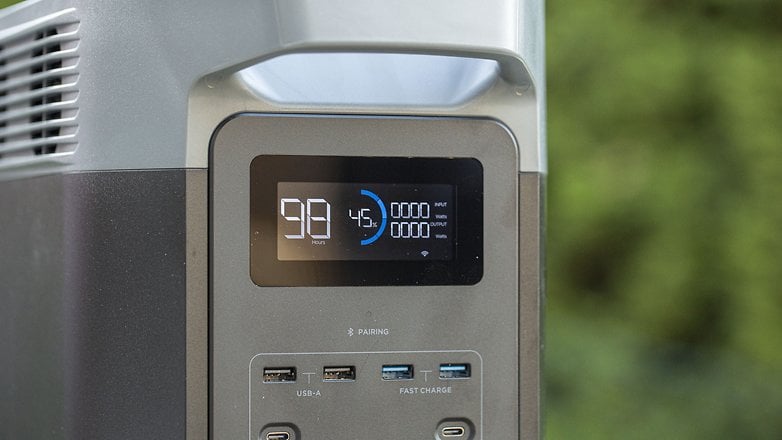
On the opposite side, you'll find an entire array of other ports, namely four 230-volt sockets as well as three 12-volt ports, one of which is in cigarette lighter format. The 230-volt and 12-volt outlets can also be switched on and off separately via a button. Finally, there is a flap above these outlets that shields the inputs from sight. Here, you'll find a DC input to charge the power station via a solar panel or the car's cigarette lighter, for example. There is also a 230-volt connection for a standard power cord.

But that's not all when it concerns connection options. As one of only a few power stations in the market, the Delta 2 also offers Bluetooth and even WLAN as well as its own app, which is surprisingly practical. The initial pairing via Bluetooth using the Ecoflow app takes just ten seconds - to connect via WLAN, you only have to select the SSID and enter the WLAN password. Doing so will allow you to see the current input and output power as well as the battery level and the remaining runtime for the current load on the app.
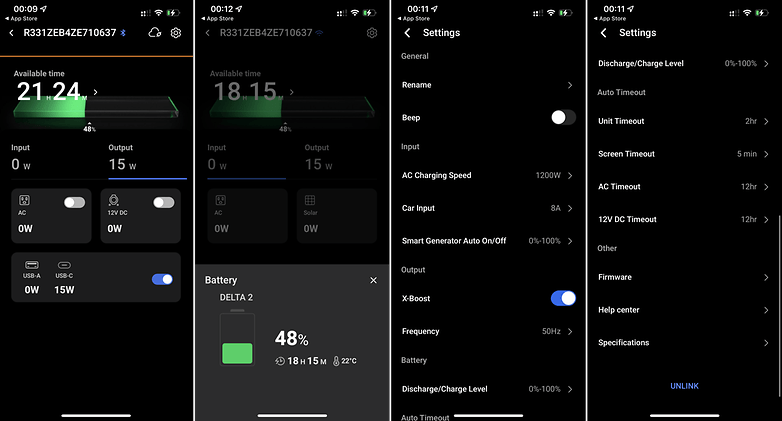
It is also practical that you can switch the individual output categories on and off via the app. Through this way, you have virtually integrated smart sockets in the power station. In addition, it is also possible to deactivate the loud beep, limit the charging power, adjust the mains frequency or set the timeouts for the different outputs in the settings.
EcoFlow Delta 2 performance
Unfortunately, we could not yet test the performance of the Ecoflow Delta 2 extensively. However, the technical data already makes us want to know more. The Ecoflow Delta 2 has a capacity of 1024 watt hours, with the maximum output power rated at 1200 watts per socket in continuous operation, and a maximum of 1800 watts is possible in total.
Pros
- Very strong output power.
- Efficient inverter.
- Power supply integrated into the housing.
- Fast charging.
- Expandable with additional batteries.
Cons
- Loud fan under full load.
The technical specifications of the Ecoflow Delta 2 are impressive on paper: The capacity of the compact power station is 1,024 Wh, and the power station can even be optionally expanded with additional batteries. The maximum output power is 1,200 W per socket in continuous operation, and a maximum of 1,800 W is possible in total. With the X-Boost function activated in the app, the power station even manages 2,400 W.
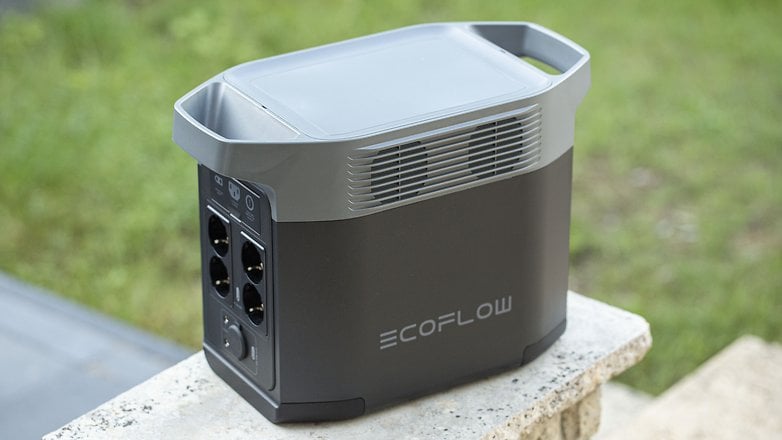
In addition, there are a number of DC outputs. The Ecoflow Delta 2 delivers up to 126 watts via the three 12-volt outlets. Out of the four USB-A ports, two provide 12 watts, and the other two, 18 watts. The two USB-C ports below are faster, each pumping up to 100 watts into your gadgets and compatible devices.
A maximum of 1200 watts is possible when it comes to the input. I find the power supply integrated into the case to be extremely practical at this point. Of course, the power station is a bit heavier than models with a separate power supply. But you have fewer parts to lug around. And if you forget to bring the power cord with you, you can quickly find a cheap replacement pretty much anywhere on the planet.

In the test, using a European-spec model (as seen on the pictures), charging worked quite quickly. It takes just 105 minutes for the power station to charge from 0 to 100 percent. The Ecoflow Delta 2 consumed a measured 1,089 Wh in the test. When discharging with just under 1,000 W, we then get 901 Wh out of the power station.
That is a respectable 88 percent of the nominal capacity. And compared to the energy put in, we get an excellent efficiency of 82.7%. The relatively high noise level under full load is a negative aspect - we measured up to 60 dB during charging and a maximum of 54 dB during discharging.
Final verdict
The Ecoflow Delta 2 differs from many other competing power stations in two points. First, it relies on LiFePO4 battery technology, which scores points with its purported long durability. Secondly, it comes with an app that offers many surprisingly practical features. On the other hand, these advantages also come at a price.
The Delta 2 is more expensive than other competitors with similar capacity and output power, for example, the Jackery Explorer 1000 Pro (review), which was also just unveiled at IFA 2022.
In the test, the Ecoflow Delta 2 impressed us with a very efficient inverter. We got 82.7% of the energy put into the power station out again. That is an excellent value in this price range. The bottom line is that the Ecoflow Delta 2 gets a clear buy recommendation from us.
- Read more: The best power stations with solar panels
- Also interesting to know: Bluetti EB55 with SP200 solar panel review




